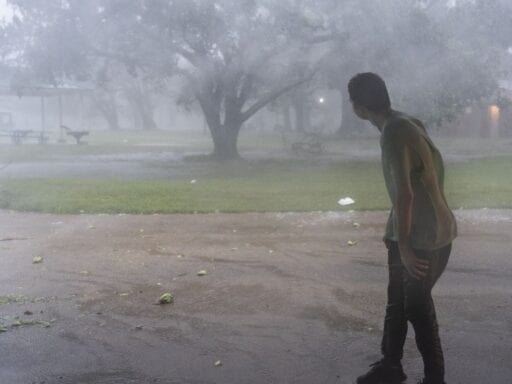Still reeling from the devastation caused by Hurricane Laura, Louisiana faces more flooding and destruction.
Hurricane Delta made landfall Friday evening in southwest Louisiana, an area that was badly impacted by the Category 4 Hurricane Laura just six weeks ago.
Delta hit the Louisiana shore in Cameron Parish’s Creole community as a Category 2 hurricane at 6:01 pm local time with 100-mph winds. (It has since been downgraded to a tropical depression.) On land, the storm brought sustained winds of 60 mph and dropped more than a foot of rain in Louisiana, with some places receiving up to 15 inches.
The National Hurricane Center (NHC) warned that heavy rainfall could lead to flash flooding — more than 5 million people are already under flash-flood warnings in the region — as well as minor river flooding across parts of the lower Mississippi River Valley and the Tennessee Valley on Saturday. Heavy rain is expected to continue into the Southern Appalachians on Sunday.
More than 800,000 people were left without power across Louisiana, Texas, and Mississippi, according to AccuWeather, and more than two dozen emergency calls included high-water rescues in areas like Baton Rouge, where the outer bands of the storm hit earlier than expected on Friday, the New York Times reported.
Delta is on the verge of becoming a tropical depression, but the storm remains a concern as it tracks across the Mississippi Valley, leaving nearly 800,000 without power: https://t.co/xsuA4FIVpi pic.twitter.com/5MX48g0wGI
— AccuWeather (@breakingweather) October 10, 2020
The storm’s strong winds flipped two trucks onto their sides on Interstate 10 between Lake Charles and Lafayette, Louisiana.
No power in our hotel in #Lafayette this morning. Saw two flipped trucks on I-10 between Lake Charles and Lafayette last night.
More than 594K customers are without electricity across Louisiana this morning after #Hurricane #Delta pic.twitter.com/vwPcGLxJwd
— Bill Wadell (@BillWadell) October 10, 2020
The NHC downgraded Delta to a tropical depression on Saturday
Delta is on track to become a tropical depression, which suggests wind speeds of less than 38 miles per hour, according to the NHC, but continued to bring wind gusts of nearly 50 miles per hour hundreds of miles inland Saturday morning.
The National Weather Service issued a tornado watch for areas in Alabama, Mississippi, and Florida until 1 pm CDT on Saturday due to the storm.
#Delta is still bringing damaging winds hundreds of miles inland … getting lots of reports of trees and power poles down. Gusts over 50 mph are common near the lowest pressure, now over northeast LA and western MS #lawx #mswx pic.twitter.com/Old1VsN1R7
— Greg Postel (@GregPostel) October 10, 2020
Delta is the 25th named storm of the 2020 Atlantic hurricane season and the 10th named storm to make landfall in the continental United States this season, setting the record for the most storms in one year, CNN reported. It’s also the seventh major storm to hit the Gulf Coast since June.
The storm first made landfall early Wednesday as a Category 2 storm 20 miles south of Cancun, Mexico. Before hitting the Yucatan Peninsula, the storm transformed from a tropical depression to a Category 4 hurricane, an escalation that one forecaster called historic.
Louisiana residents were still dealing with the aftermath of Hurricane Laura, which hit the state as an “extremely dangerous” storm in late August during the 15th anniversary of Hurricane Katrina. Winds that gusted at up to 130 miles per hour removed rooftops, flipped trees, and downed power lines. At least 10 people died in Louisiana from falling trees. “It just looks like a bomb went off,” a resident told Vox.
Lake Charles Mayor Nic Charles told the Wall Street Journal before Delta made landfall, “We are still reeling from Laura. There are thousands of buildings in this city that were weakened from Laura that are nowhere near put back together. There are still piles of debris left. You just can’t recover from a catastrophe in six weeks.” Lake Charles, where 95 percent of structures suffered damage from Laura, is north of Creole, where Delta first hit.
The year’s particularly intense hurricane season is due in part to climate change. As Vox’s Umair Irfan reported, “warmer-than-average sea surface temperatures in the Atlantic and the Caribbean Sea” has created more energy for hurricanes to “spin up, grow, and strengthen.” Shifts in wind patterns are also a factor:
Shifts in wind speed and direction with altitude, known as wind shear, can prevent storms from forming or rip apart weather systems before they blossom into major storms. But this year, the air over the North Atlantic was more placid, with less wind shear than is typical.
The National Oceanic and Atmospheric Administration predicted a busier-than-normal hurricane season in the Atlantic this year. “The agency forecast 13 to 19 named storms, of which six to 10 would become hurricanes. Of those, three to six would become major hurricanes. This is higher than an average season, which produces 12 named storms, six hurricanes, and three major hurricanes,” Irfan wrote.
The NHC expects minor to major river flooding to continue across parts of Louisiana and Mississippi throughout the week.
Millions turn to Vox each month to understand what’s happening in the news, from the coronavirus crisis to a racial reckoning to what is, quite possibly, the most consequential presidential election of our lifetimes. Our mission has never been more vital than it is in this moment: to empower you through understanding. But our distinctive brand of explanatory journalism takes resources. Even when the economy and the news advertising market recovers, your support will be a critical part of sustaining our resource-intensive work. If you have already contributed, thank you. If you haven’t, please consider helping everyone make sense of an increasingly chaotic world: Contribute today from as little as $3.
Author: Fabiola Cineas
Read More



